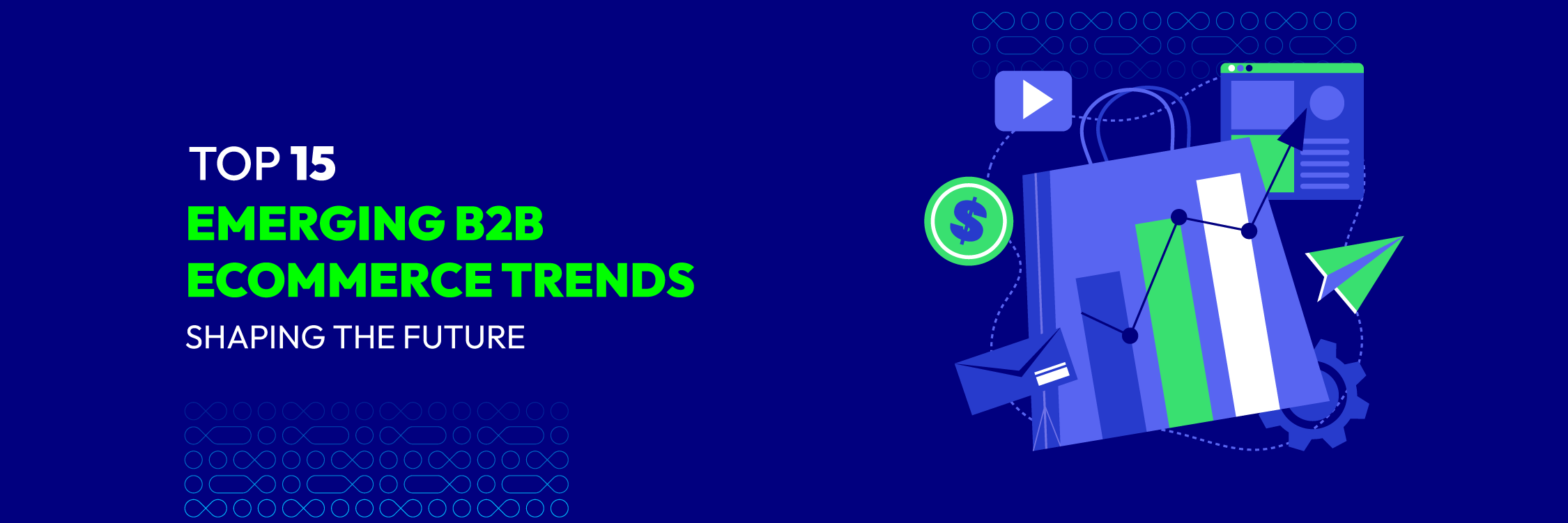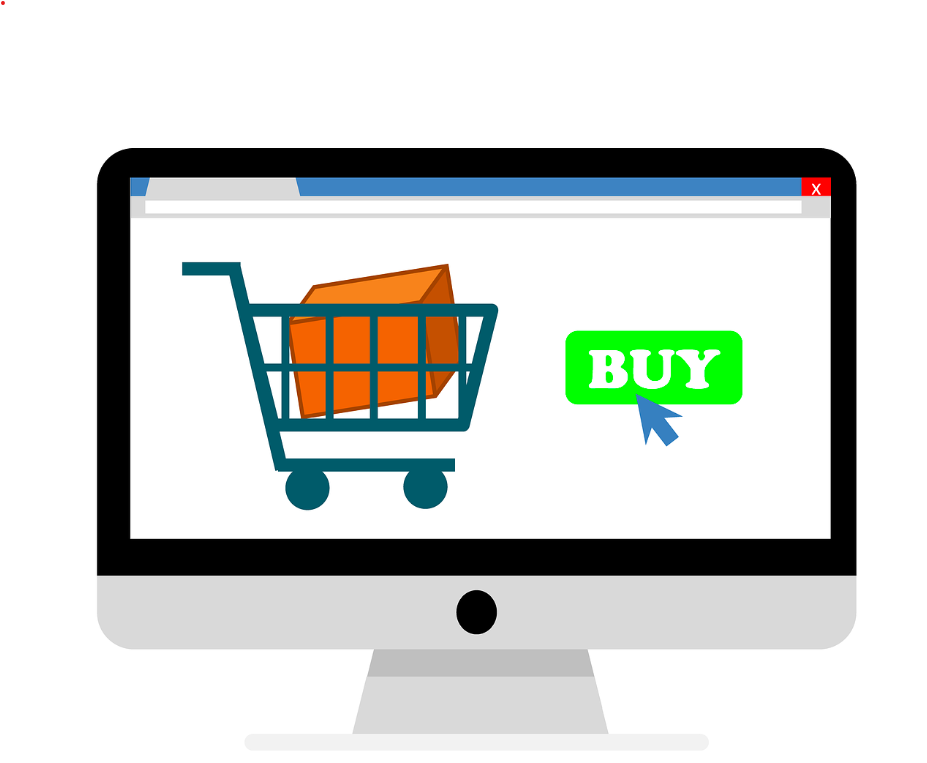Top 15 Emerging B2B Ecommerce Trends Shaping the Future
Summer Nguyen | 09-16-2023


The Most Popular Extension Builder for Magento 2
With a big catalog of 224+ extensions for your online store
Navigating the ever-evolving landscape of B2B ecommerce requires an astute understanding of emerging trends that are reshaping the way business transactions unfold. As industries adapt to changing customer preferences, technological advancements, and market dynamics, staying ahead of the curve is essential for sustainable growth and competitiveness.
From the integration of innovative technologies to the rise of sustainability and customer-centric strategies, top 15 B2B ecommerce trends offer insights into the strategies that can elevate B2B businesses to new heights in today’s dynamic digital marketplace.
Table of Contents
- Top 15 B2B Ecommerce Trends
- 1. Social Commerce Will Give Prospects New Shopping Options
- 2. Hyper-Personalization: Treating Each Business as a Unique Entity
- 3. Mobile Optimization Takes Center Stage
- 4. Ecommerce Tools Will Automate Sales
- 5. Omnichannel Retail Sales Set to Expand
- 6. Product Discovery Data Will Be Essential
- 7. Video Content Won’t Be Just for B2C Brands
- 8. Brands Will Invest in Headless Commerce Architecture
- 9. Voice Search Will Enable More Product Discovery Opportunities
- 10. Sustainable eCommerce Will Gain Importance
- 11. Dynamic pricing will see increased prevalence
- 12. Increasing importance of transparency
- 13. Broader range of payment choices
- 14. Growing demand for real-time inventory
- 15. After-sales service will be a key revenue driver
- How to Determine if a Trend Makes Sense for You
- The Final Word
Top 15 B2B Ecommerce Trends
1. Social Commerce Will Give Prospects New Shopping Options

Social commerce is undergoing a metamorphosis, extending its influence into the B2B sphere. Beyond being platforms for networking and brand visibility, social media channels like LinkedIn are emerging as hubs for lead generation, relationship building, and even transactions.
In 2023, harnessing social commerce means leveraging these platforms not just as megaphones for your brand but as conduits for seamless shopping experiences.
As per insights from Insider Intelligence, around 36% of U.S. internet users engage in social buying, equating to roughly 90.2 million individuals. Due to the increasing importance of social media in the shopping realm, it’s advisable to persist in enhancing ecommerce strategies tailored for these platforms.
2. Hyper-Personalization: Treating Each Business as a Unique Entity
Hyper-personalization has evolved beyond personalized email greetings. B2B buyers now anticipate recommendations that align with their specific industry, challenges, and aspirations. As the data ecosystem expands, businesses must leverage AI-driven analytics to dissect buyer behaviors and preferences.
Given that, a staggering 80% of B2B buyers anticipate tailored recommendations by 2023. The goal is to not just offer products but solutions tailored to individual needs, fostering a sense of partnership rather than just a transaction.
3. Mobile Optimization Takes Center Stage
Mobile optimization is no longer an option but one of necessary B2B ecommerce trends. In the first quarter 2023, mobile devices contributed to 58.33% of all global website traffic. As this number continues to rise, B2B businesses must prioritize mobile-responsive designs to provide seamless experiences to their clients.
Indeed, the projected figure for mobile commerce transactions is set to reach $620.97 billion by 2024, indicating that 42.9% of total ecommerce acquisitions will originate from mobile devices. By enhancing your website’s mobile-friendliness, you can effectively engage with customers on the platforms they prefer.
4. Ecommerce Tools Will Automate Sales
Ecommerce tools are revolutionizing lead qualification through data-driven algorithms that assess lead quality based on predefined criteria. This approach enables sales teams to focus their efforts on leads with the highest potential, boosting efficiency and conversion rates. Moreover, the creation of automated quotations and proposals aligned with customer needs significantly reduces turnaround time, providing a seamless journey from inquiry to formal proposal.
Dynamic pricing strategies are being implemented with the help of real-time data analysis, allowing businesses to adjust prices based on market trends, competitor pricing, and demand fluctuations. This not only enhances competitiveness but also maximizes revenue by capturing optimal pricing opportunities. Automation also facilitates complex order customization and configuration, empowering B2B buyers while minimizing errors during the order placement process.
Ecommerce tools can be divided into the following groups:
- Ecommerce Platforms: Comprehensive solutions that manage all aspects of online selling, from product listing to checkout.
- Website Building and Design: Tools for creating and customizing appealing and functional online stores.
- Inventory Management: Software to track and manage product inventory, ensuring accurate stock levels.
- Payment Processing: Tools that handle secure payment transactions and manage refunds.
- Order Fulfillment and Shipping: Solutions for efficient order processing, packing, and shipping.
- Marketing and Analytics: Tools for promoting products, analyzing performance, and driving traffic.
- Customer Relationship Management (CRM): Software to manage customer data and interactions for personalized experiences.
- Security and Fraud Prevention: Solutions to protect customer data and prevent fraudulent activities.

Google Analytics 4 for Magento 2
A clear insight into shopping and behavior of customers with 5 advanced reports
Check it out!5. Omnichannel Retail Sales Set to Expand
Statistics from Statista indicate a notable shift towards digital platforms for B2B sales. It is estimated that 17% of B2B sales will be digitally generated in 2023. This shift is substantiated by a Gartner survey from late 2021, revealing that a considerable 83% of B2B buyers prefer utilizing digital channels for placing orders and making payments. Meanwhile, omnichannel plays a critical role as an emerging B2B ecommerce trend.
Omnichannel sales refer to a retail approach where businesses provide a seamless and integrated shopping experience across various channels and platforms, such as physical stores, online stores, mobile apps, social media, and more.
The goal is to create a consistent and convenient experience for customers, allowing them to interact and make purchases through multiple touchpoints while maintaining a cohesive brand experience.
The omnichannel experience isn’t just a buzzword; it’s an acknowledgment of the multifaceted journey B2B buyers undertake. Research indicates that companies with robust omnichannel engagement retain an average of 89% of their customers. This trend reflects the understanding that B2B buyers interact with brands across various platforms and touchpoints.
Ensuring consistency and seamlessness across these interactions is what differentiates an average experience from an exceptional one.
6. Product Discovery Data Will Be Essential

A major challenge faced by B2B online shoppers is locating products, and even if the products are found, difficulties persist in accessing current information about them.
Various solutions exist for addressing this concern within the realm of B2B. One approach involves the utilization of product information management (PIM) software. PIMs prove advantageous as they gather, oversee, enhance, and disseminate product details across diverse channels – encompassing ecommerce websites, mobile applications, social sales platforms, marketplaces, and even advertising networks.
Alternatively, B2Bs can opt for back-office technology solutions that automate manual tasks. Many B2Bs currently rely on spreadsheets for product information and inventory management. However, by integrating an appropriate back-office system, such as an Enterprise Resource Planning (ERP) system, all catalog data can be consolidated into a single location seamlessly linked with the website. This ensures that updates and modifications are reflected in real time.
An accessible strategy also involves the deployment of chatbots. These automated systems can effectively guide shoppers towards product pages or encourage them to initiate conversations with the B2B sales team, especially if the shoppers are new to making purchases from the business.
7. Video Content Won’t Be Just for B2C Brands
Video content isn’t just a medium for information; it’s a tool for engagement. B2B buyers seek immersive experiences that go beyond static product descriptions.
Videos offer the avenue to demystify complex solutions, enabling businesses to foster deeper understanding and trust. This trend heralds a shift from traditional product showcases to dynamic narratives that resonate with the modern buyer.
8. Brands Will Invest in Headless Commerce Architecture
Headless commerce architecture empowers B2B enterprises to disconnect the front-end and back-end components of their website, granting them increased flexibility to construct and tailor various elements according to their preferences.
The adoption of the headless approach is attributed to its capacity for simplifying the development and provision of individualized shopping journeys.
Upon implementation, the headless architecture streamlines the process of reducing website-related expenses, eliminating the requirement for technical assistance whenever minor modifications to the front-end necessitate adjustments in the back-end.
9. Voice Search Will Enable More Product Discovery Opportunities

As per Google’s findings, voice search is embraced by 27% of the worldwide internet user base on mobile devices. Furthermore, a significant 72% of individuals who engage in voice search do so on a daily basis.
Voice search is rapidly emerging as one of game-changing B2B ecommerce trends. Offering a seamless, hands-free experience, it transforms how businesses interact with online platforms. Natural language interaction bridges user intent and results, enabling swift and efficient searches, which is particularly crucial in fast-paced B2B contexts.
Mobile convenience is a highlight, as professionals can search on the go. Adjusting keyword strategies becomes imperative, as voice search demands a shift towards natural language and long-tail keywords. Integration with virtual assistants adds another layer of usability and efficiency.
Contextual searches and personalized recommendations enhance user experience, while early adoption offers businesses a competitive advantage. Voice search not only anticipates evolving user preferences but also generates valuable data for refined marketing strategies. As voice search gains traction, businesses integrating this technology are poised to lead the way in B2B ecommerce.
10. Sustainable eCommerce Will Gain Importance

According to Forrester, a remarkable surge is anticipated, with B2B e-commerce projected to reach $3 trillion in the US by 2027, a substantial increase from the $1.7 trillion recorded in 2021. The current landscape of B2B ecommerce is marked by significant trends, one of them is “green” ecommerce.
The B2B ecommerce sector is undergoing a notable transformation marked by the surge of sustainable practices. This burgeoning trend is driven by environmental awareness and consumer demands for ethically-conscious business operations. B2B enterprises are now integrating sustainability as a core element of their strategies, focusing on various aspects.
Supply chains are undergoing a “green” shift, prioritizing eco-friendly practices from sourcing to transportation. Packaging is also evolving, with businesses adopting biodegradable and recyclable options. Circular economy principles are gaining ground, encouraging repair services and recycling initiatives to extend product life cycles.
Energy efficiency is paramount, with companies adopting renewable energy sources and sustainable logistics. Transparent sustainability reporting is becoming standard, enhancing trust and showcasing responsible practices. Ethical partnerships with like-minded suppliers are on the rise, aligning values across the supply chain.
Beyond environmental impact, sustainable practices have become a potent B2B marketing strategy. Businesses are leveraging their commitment to sustainability to enhance brand image and attract conscientious clients. Ultimately, sustainable ecommerce is not just a trend but an essential shift that’s reshaping B2B ecommerce practices and forging a path towards responsible and prosperous business models.

Discover Magento 2 B2B today and bring your wholesale business to the next level
Check it out!11. Dynamic pricing will see increased prevalence
The concept of dynamic pricing is poised to become a common B2B ecommerce trend. Although it’s a strategy that has been utilized regularly within the vacation rental industry, its application has recently attracted the eCommerce sector’s attention. As technology advances, B2B enterprises now possess greater authority over their pricing structures. This empowers them to delve into the notion of adjusting their prices in real-time based on fluctuations in supply and demand.
Given the recent surge in inflation rates, adopting real-time pricing stands to benefit B2B businesses by maintaining their competitiveness. Beyond aiding in more efficient price management, it also has the potential to enhance the personalized customer experience. This trend holds significance as it offers mutual advantages for both buyers and sellers, making it one of the most impactful trends for an organization’s future success. It exemplifies the possibility of simultaneously augmenting customer loyalty and profit margins.
12. Increasing importance of transparency
In the past, buyers relied on events like trade shows to engage with suppliers, facilitating in-person discussions on matters like pricing and quality. However, the advent of B2B eCommerce has shifted many of these interactions into virtual spaces.
Despite this shift, factors such as quality and pricing continue to hold significant importance for buyers. As a result, B2B eCommerce enterprises are poised to enhance their focus on ensuring complete transparency regarding product quality and pricing. While transparency is not a new concept for business success, its importance is set to magnify further in the future of B2B ecommerce.
Beyond product quality and pricing, transparency concerning delivery timelines will also gain prominence in the eyes of buyers. This encompasses not only the availability status of products (linked to real-time inventory management) but also the anticipated delivery dates for their orders. Consequently, a growing number of B2B businesses are turning to software solutions capable of automatically displaying delivery dates.
This shift towards increased transparency aligns with the evolving landscape of B2B ecommerce trends and underscores the importance of meeting buyer expectations regarding information accessibility.
13. Broader range of payment choices

With a growing emphasis on tailoring experiences for customers and the prevalence of online marketplaces, there is an anticipation of a broader range of novel payment choices emerging in the future. This projection entails an increasing number of B2B enterprises revamping their payment systems to accommodate various innovative payment methods. Furthermore, it is expected that digital payment mechanisms within the B2B sector will mirror the diverse options currently utilized in the retail sphere.
This trend has already gained significant traction over the past couple of years and is set to gain even more prominence in 2023. The provision of adaptable payment alternatives is becoming increasingly critical. Essentially, failing to offer buyers the convenience of their preferred payment modes is likely to impact sales in the forthcoming years.
14. Growing demand for real-time inventory
In the coming times, it will be an increasingly vital B2B ecommerce trend for B2B enterprises to present their stock availability with precision. Essentially, customers require information about available stock levels when placing orders. Keeping inventory updated in real time can offer customers the essential confidence that their products will be delivered punctually. If your business has not yet established such a system, considering its implementation becomes a valuable investment for the years ahead, starting from 2023.
15. After-sales service will be a key revenue driver
B2B enterprises currently possess a substantial revenue-generating potential through a strategic application of technology: after-sales services. Leveraging self-service platforms and order histories can facilitate repeat orders, highlight pertinent spare parts, and suggest upgrades or repair services. According to Deloitte, after-sales services have the capacity to augment market players’ total revenue by 50%. Notably, numerous companies are already generating half of their overall revenue from this domain.
How to Determine if a Trend Makes Sense for You
Prioritizing B2B ecommerce trends for adoption requires careful consideration, as not all trends are equally applicable. While certain trends can provide significant value, others might not resonate with your specific audience or may entail excessive implementation costs that undermine a favorable ROI.
Gauging the suitability of trends often boils down to your profound familiarity with your customers, industry dynamics, and competitive landscape. The process of evaluating industry trends and making informed decisions for your business encompasses several key steps:
1. Stay Informed through Industry Reports and Data
Keeping abreast of industry developments is pivotal. Regularly perusing reports and data sheds light on industry trajectories. These resources, grounded in research, offer reliable insights compared to mere hearsay. Staying informed enables you to discern trends worth pursuing from those better left for later evaluation.
2. Analyze Customer Behavior
Leverage the advantage of having first-party customer data in B2B ecommerce. Scrutinizing customer behaviors and preferences yields invaluable insights. Quantitative data extracted from web analytics uncovers the “what,” while qualitative data from surveys and feedback unveils the “why.” This approach cultivates a culture driven by data and validates assumptions.
3. Seek Direct Feedback from B2B Customers
Directly engaging with customers unveils deeper insights into their challenges and potential solutions. Feedback from existing customers enriches trend analysis and aids in crafting targeted strategies for the future of B2B ecommerce. Additionally, customers might unveil innovative ideas that had not previously been considered.
4. Evaluate Competitor Strategies
Probe into your competitors’ strategies. Did they embrace a specific trend? If so, how well did it fare for them? While replication is unnecessary, understanding competitors’ choices serves as a gauge for a trend’s potential success.
The Final Word
E-commerce capabilities have become a prevalent aspect of B2B enterprises. McKinsey & Company’s B2B Pulse 2022 report highlights that nearly two-thirds of B2B companies across industries offer e-commerce capabilities, showcasing a notable rise from the 53% reported in early 2021.
From mobile optimization to headless commerce, these trends are not just shifts; they are opportunities to redefine how businesses connect, transact, and excel. By embracing these trends, companies can position themselves as pioneers in an evolving landscape, crafting experiences that resonate with customers, drive innovation, and pave the way for a transformative B2B ecommerce journey.
However, the landscape of B2B ecommerce trends is in a constant state of flux. To retain a competitive edge, your company must stay attuned to the ever-evolving trends and assess which ones warrant your focus.



